Welcome to Old School Month on Eternal Central. In our first primer we’ll take a look at a cool hybrid strategy that I refer to as “JunkShop Reanimator.” Junk for the colors black, green, and white (which historically has been referred to as “Junk,” for old Pro Tour decks), Shop for the Mishra’s Workshops that help fuel the deck, and Reanimator for the reanimation spells that help bring back our fatties.
Here is the original version of the deck I piloted last year in local play amongst our Chicago Old School scene.
Played this JunkShop Reanimator brew in Chicago #OldSchoolMTG 93-94 this week. Jalum Tome/Bazaar + Sylvan = synergy. No blue intentionally. pic.twitter.com/eIi09xS1It
— Jaco (@JMJACO) December 17, 2016
Constructing JunkShop Reanimator
There are a number of ways to construct Reanimator decks in Old School, usually revolving around some combination of Animate Dead, All Hallow’s Eve, Resurrection, and Hell’s Caretaker. The typical recipe is to use cards like Bazaar of Baghdad, Jalum Tome, or Mind Bomb to dump cards in to the graveyard, and then reanimate a giant monster using one of the aforementioned techniques.
Following along this path, the best creatures you can generally reanimate in the Old School 93-94 pool of Alpha through Fallen Empires are probably Deep Spawn and Nicol Bolas. After that the offerings are rather unimpressive, with the creatures simply being large flying monsters, being easy to remove, or containing significant drawbacks.
Here is an updated version of the deck, which we’ll be examining more thoroughly in this article.
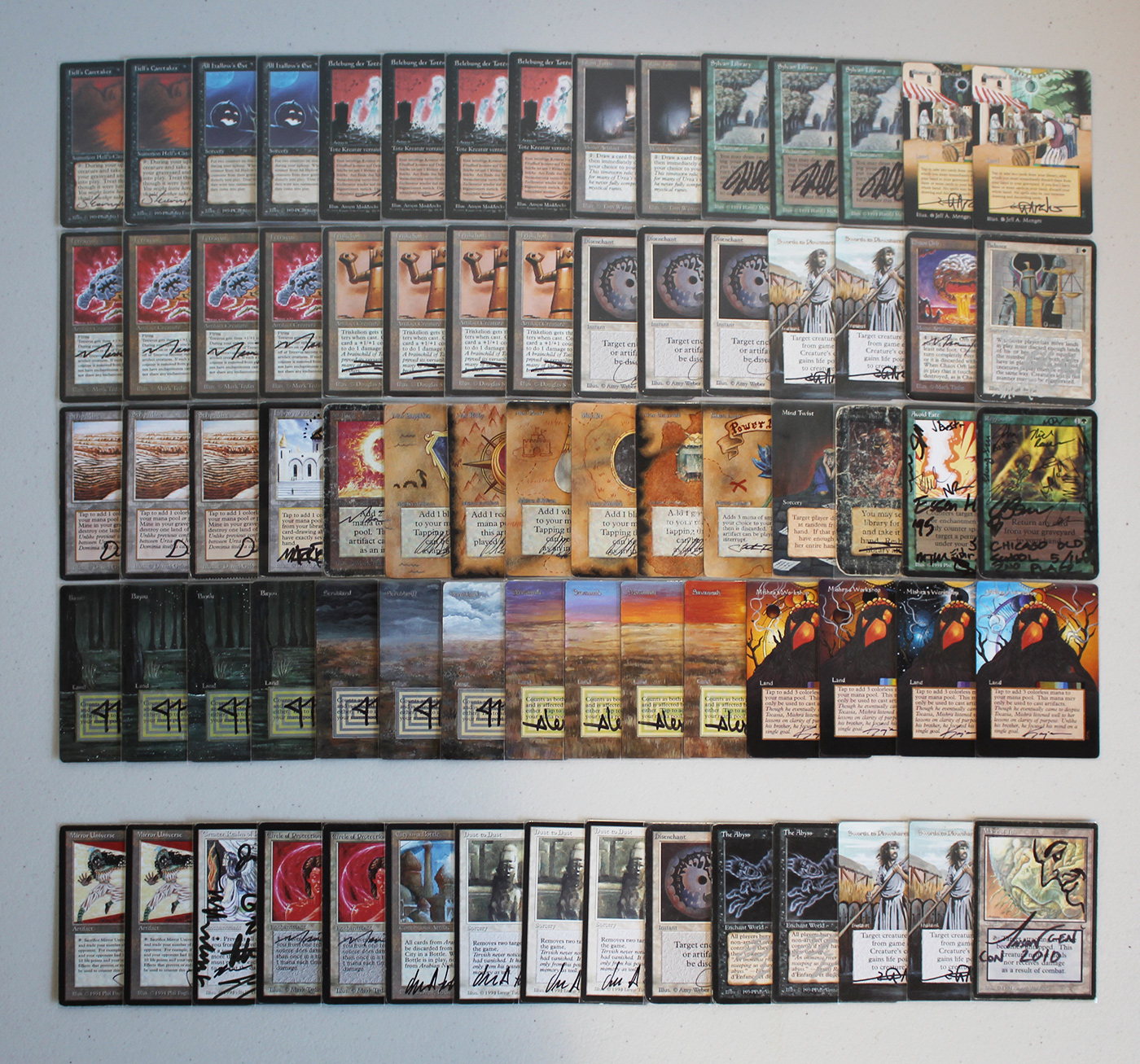
Creature Choices
JunkShop Reanimator diverges from this path slightly, in that the tools present give the controller more opportunities to cast the monsters, rather than exclusively rely on reanimating them. This gives you more ability to grind through counterspells and removal, as well as the ability to play around hate cards like Tormod’s Crypt.
The contrast of this strategy compared to other Reanimator strategies is that you will often simply be hard casting your creatures on curve, as opposed to relying on only reanimating them with All Hallow’s Eve or Animate Dead. Having access to 4 Mishra’s Workshops lets you reliably cast Triskelion and Tetravus, as compared to something like Deep Spawn (which is undoubtedly the best reanimation target in sets printed through 1994). With that in mind, let’s look at the creatures that would best fit this idea of a hybrid reanimation + hard casting with Workshop strategy.
Triskelion is a great card in Old School, for its ability to pick off smaller creatures like Savannah Lions, Preacher, and various Knights, while also still being large enough when cast to be out of Lightning Bolt range.
Tetravus may appear a bit underwhelming for a Reanimator strategy at first, but consider what it does. Like Triskelion, Tetravus enters the battlefield large enough to survive a Lightning Bolt or Chain Lightning. Its +1/+1 counters can be removed at the beginning of your upkeep (this timing is important to remember) to create individual 1/1 flying Tetravite tokens. Not only does this make one-for-one removal against Tetravus worse (because the other Tetravites will still be around), but it also enables you to fly over Moat.
Hell’s Caretaker is a fragile 1/1 body, but if it survives it can transform the game. It can be used to bring back fatties from the graveyard, and when used in conjunction with Tetravus, can start getting abusive. Remove counters from Tetravus to create 1/1 Tetravite tokens during your upkeep, and then tap Hell’s Caretaker during your upkeep to trade one of those tokens for another monster in the graveyard. This can allow you to cycle more Tetravus’ in to play, or cycle through Triskelions to do a bunch of pinging damage (by removing the counters from Triskelion).
You can always experiment with different creatures in Reanimator depending on what you are trying to do, but this is a great starting point for a Workshop-fueled variant.
The Sylvan Bazaar Engine
One of the most potent, and underused, engines in Old School 93-94 is that of Sylvan Library in conjunction with Bazaar of Baghdad. Sylvan Library is a great card on its own at nearly any point in the game, and allows you to reduce variance in your draws and find critical cards faster. Bazaar of Baghdad lets you dump creatures in to your graveyard to be reanimated later, and lets you transform what might otherwise be dead cards in hand in to more gas. When used in conjunction though, this engine can be abused in this deck and others. If you have Sylvan in play with no cards in hand, you can tap Bazaar to simply mill away the top two cards of the deck in to the graveyard, so that next draw step you see three new cards. You can dig faster and deeper for threats and solutions, given more ability to find what you need in a given circumstance.
Similarly, Jalum Tome has synergy with Sylvan and Bazaar, while also cheaply allowing you to dump creatures in to the graveyard for reanimation purposes, or simply cashing in dead cards from hand towards more live draws.
Removal
Playing White in Old School 93-94 affords you the option of having the most efficient removal spells in the format, in the form of Swords to Plowshares, Disenchant, Balance, and Dust to Dust. Sprinkle these to taste as your metagame requires.
Designing the Sideboard
There are many different directions to go when building the sideboard for this deck, but in the current version posted above, I wanted access to damage prevention or life gain against the decks that use a lot of burn spells to quickly reduce your life total. Circle of Protection: Red and Greater Realm of Preservation are very useful in that regard, as is Mirror Universe, which also has many more uses (including great synergy with Sylvan Library).
Dust to Dust is a great answer to opposing artifact decks, as well as decks relying on tons of fast mana and Jayemdae Tome.
One thing this deck is potentially weak to is a very fast draw from RUG and GRW Zoo decks. Those decks feature very low to the ground threats, and tons of removal. I like to side in additional copies of Swords to Plowshares and The Abyss in particular, in favor of the more fragile Preacher and Hell’s Caretaker, which are unlikely to live long against decks with so much burn.
Playing JunkShop Reanimator
Playing this deck takes some practice, as there are a lot of moving parts. So let’s dig in a little bit to examine some common lines, and playing against removal.
Recurring Patterns of Play
Games can play out vary differently with one another when piloting this deck, depending on what kind of resistance you’re facing, and what your draws look like. One common path to victory will simply be to find a Mishra’s Workshop and then use it to cast your bigger creatures faster than your opponent can keep up with. Another line if you are more mana light will be to use your draw engine of Sylan, Bazaar, and Jalum Tome to dump creatures or excess removal in to the graveyard, while digging for an Animate Dead or All Hallow’s Eve.
When I’m playing against a slower deck with a lot of counterspells, I like to play a little slower and build up a mana base and start ramming large creatures in to play every turn, making the opponent either burn a counterspell or a removal spell. The odds are you will have more threats than they do answers, and Sylvan Library is your best card here. You can usually draw extra cards aggressively with Sylvan in exchange for life, especially when playing against Swords to Plowshares, which will just give you more life (and cards) to play with. Unless you need to, don’t ever let a Swords to Plowshares remove a Triskelion from the game. Remove the counters to do damage to the opponent in response, and save one last counter to do a point of damage to Triskelion itself (killing it, and sending it to the graveyard for later reanimation).
Against aggressive decks that are loaded with burn, you need to be more measured when using Sylvan Library, as taking a single extra card can often mean the difference between life and death. Against these decks repeatedly reanimating your Triskelions and Tetravuses are often more than they can handle, especially once you have gotten to a point in the mid game where you are able to just hard cast everything you draw.
Disenchant is the best commonly played removal spell against this deck, so I like to aggressively remove all of the counters from Tetravus during my first upkeep available, so that there are some threats left over in case it gets removed from play. This can be tempered if playing against a UR deck for example, where it will be more beneficial to have a flying 4/4 creature in play against Serendib Efreet and/or burn spells that can only do 3 damage each.
Ten Opening Hands with JunkShop Reanimator
Here are ten randomly drawn opening hands with the deck (in order, and not manipulated in any way), and a few brief words with how I might look to play said opening hands.
Opening Hand 1
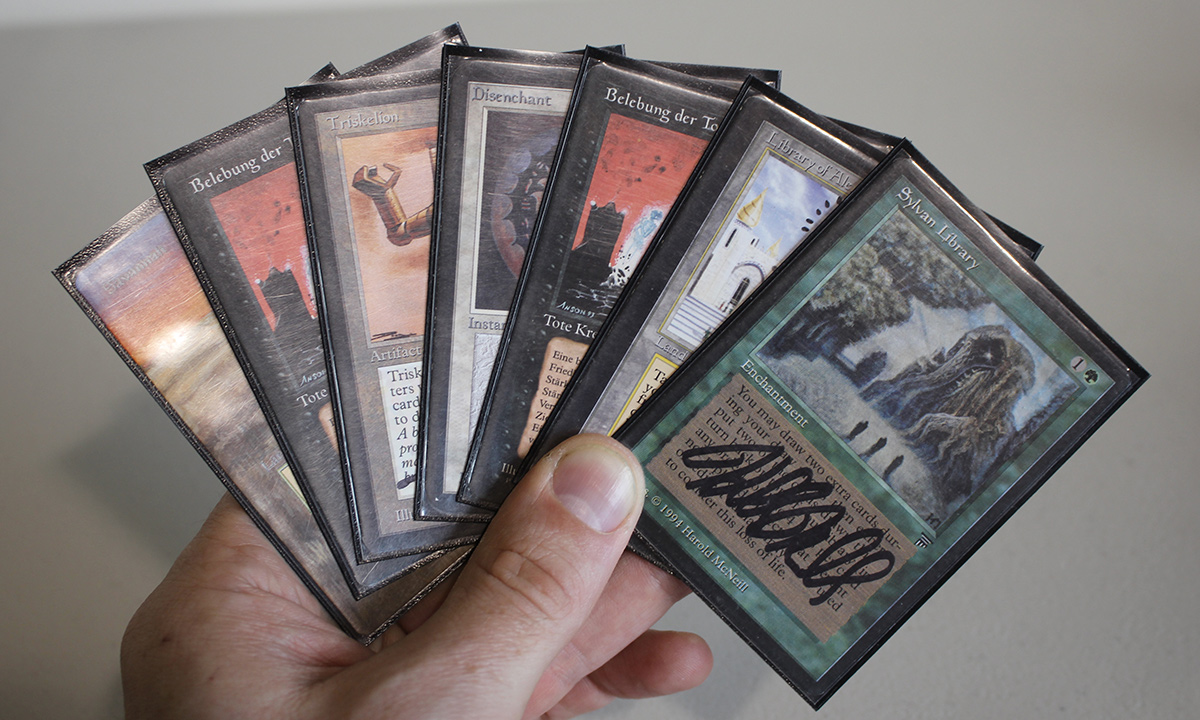
This hand has Library of Alexandria, and the mana to cast Sylvan Library, so it’s pretty much a snap keep. This will likely play out slowly by drawing an extra card every turn with Library of Alexandria until the opponent can deal with it. If they have a quick Strip Mine we’ll try to go off to the races with Sylvan Library.
Opening Hand 2
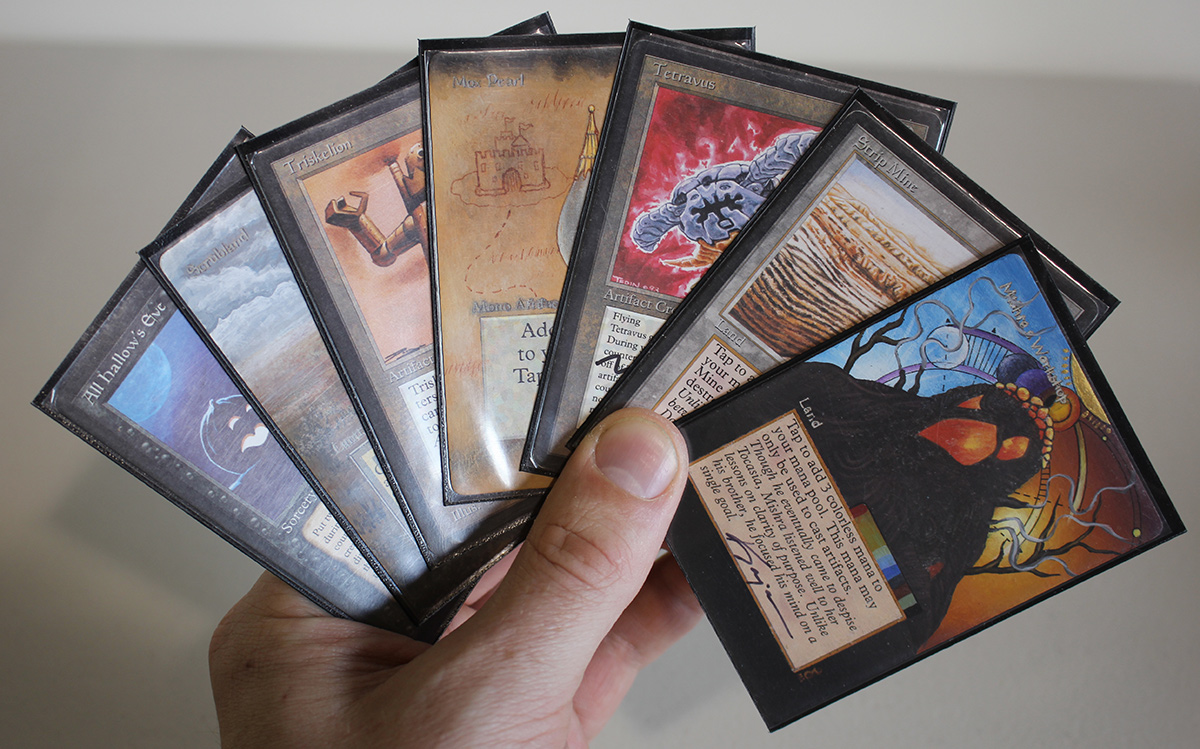
This hand has good mana, and a plan to cast a quick Triskelion and then Tetravus. It also has an All Hallow’s Eve to help recur the beasts after they’ve been killed or countered. I’d recommend playing the Strip Mine on the first turn and passing. This is to protect your own more important lands for future turns, because if the opponent has a Strip Mine in their opener they will likely be incentivized to use it first, before deploying other lands (for the same reason). The goal here is to drop your Workshop in to play last, on the turn you’re ready to cast one of your six-drops (probably on the third turn, given the opening hand resources).
Opening Hand 3
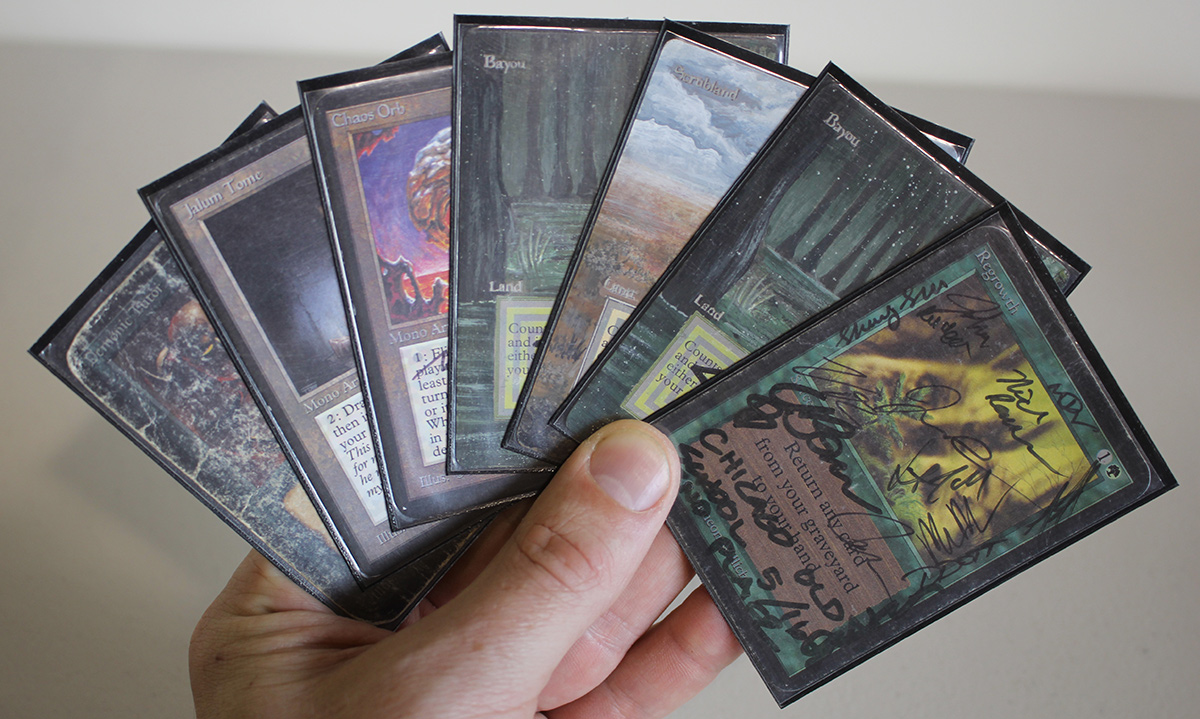
This hand has on-color mana, removal (Chaos Orb), Regrowth, a draw filterer (Jalum Tome), and most importantly, Demonic Tutor. It’s a keep. Depending on how the game shakes out, Demonic can be used to get more removal, a Strip Mine, Sylan Library, Workshop, Mind Twist, or a threat like Triskelion. Demonic is one of the best cards in this deck, and this demonstrates why.
Opening Hand 4
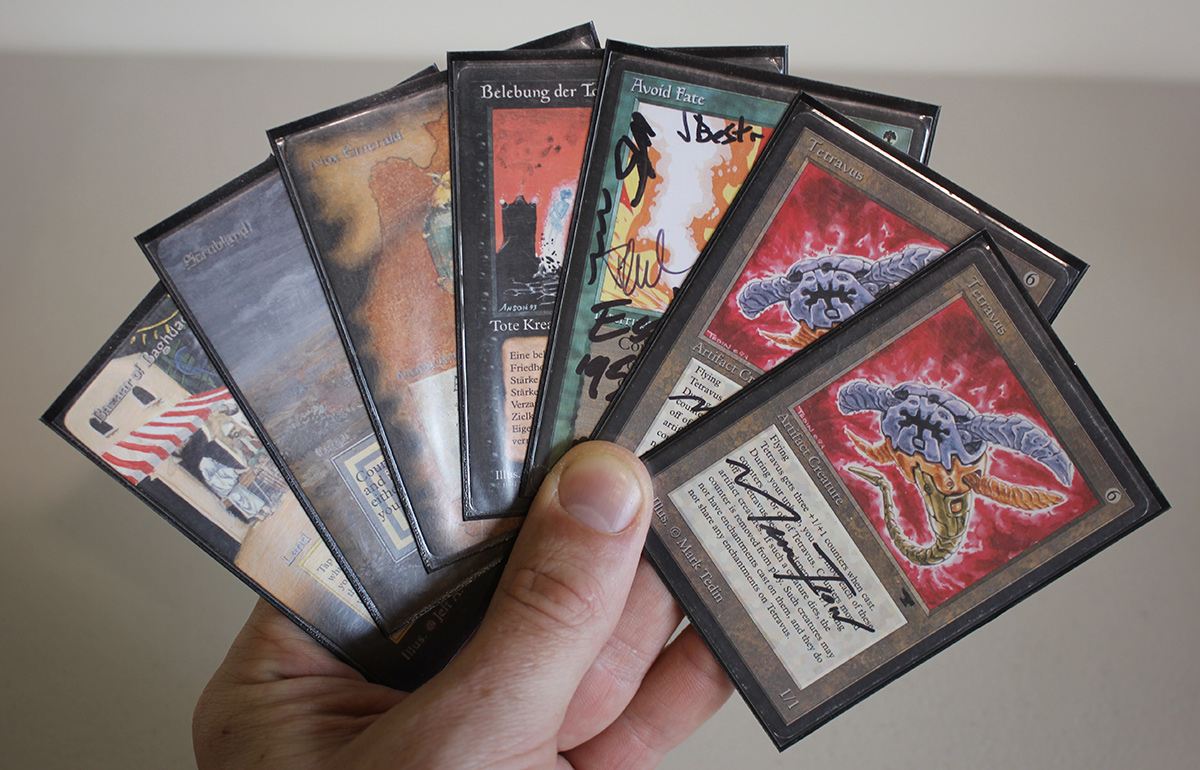
Given the texture of this hand, our most likely path to victory is to drop the Bazaar of Baghdad in to play on the first turn, and use it to dig for more mana and reanimation effects. Given what’s already in hand, Animate Dead can be cast on a Tetravus on the second turn, or with patience and the right draws from Bazaar, potentially on the third turn with Avoid Fate backup (to counter a Swords or Disenchant). This is an average hand, worth keeping.
Opening Hand 5

This hand features plenty of mana, a Disenchant, and the mighty Sylvan Library. This hand seems pretty dependent on Sylvan, but if it sticks around you are almost assuredly going to win this game, given that you can cast whatever you draw from turn two onwards. Jalum Tome can be used in the mid game to dig further, either with or without Sylvan.
Opening Hand 6

This opener can cast Swords to Plowshares and little else, with no reasonable path to victory, especially if you get Strip Mined. Let’s mulligan and hope for a better six.
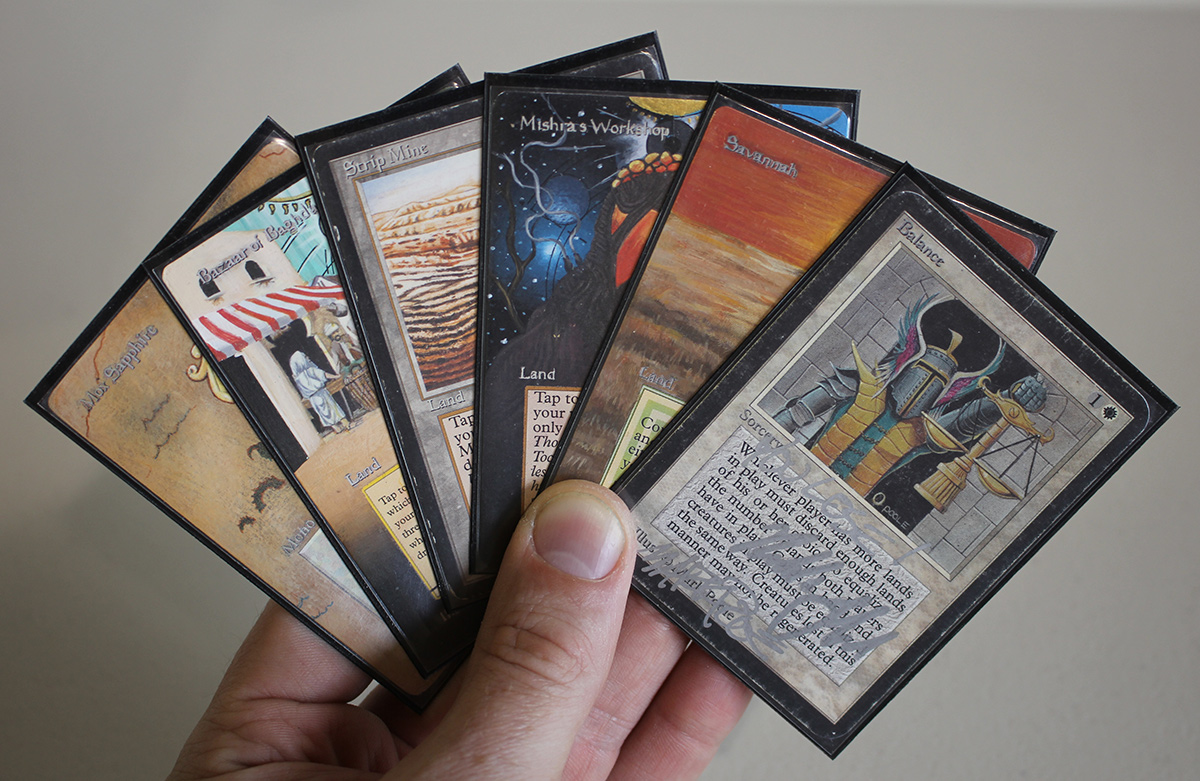
While there are no threats in this hand, it has great mana, a Strip Mine for disruption, and Bazaar of Baghdad to dig later on. It also has the ability to use Balance for protection, or for an empty-handed blowout in a few turns (illustrating the power of Balance in deck with Bazaar of Baghdad). It’s a keeper.
Opening Hand 7

With good mana and Library of Alexandria present in this opener, this is a snap keep. You can play this game slowly and out-draw your opponent if Library goes unchecked, and if there’s able to deal with that, or able to get down a handful of fast threats, you can drop your fast mana and then Balance them back to the Stone Age.
Opening Hand 8
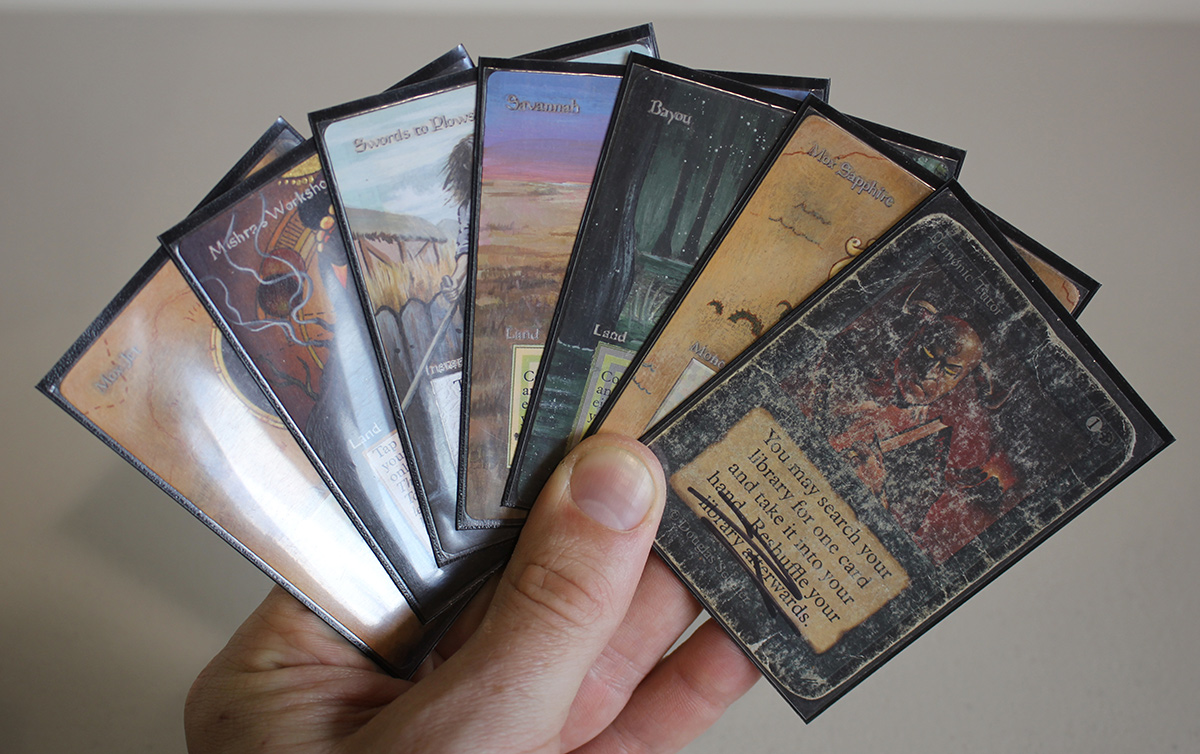
This hand features all the mana you could want in your opener, along with Demonic Tutor. I’d likely keep this hand and start by playing Bayou and Sapphire to cast Demonic Tutor for Sylvan Library (if I think it will stick around), or potentially grabbing Mind Twist if I think it will fatally damage the opponent.
Opening Hand 9
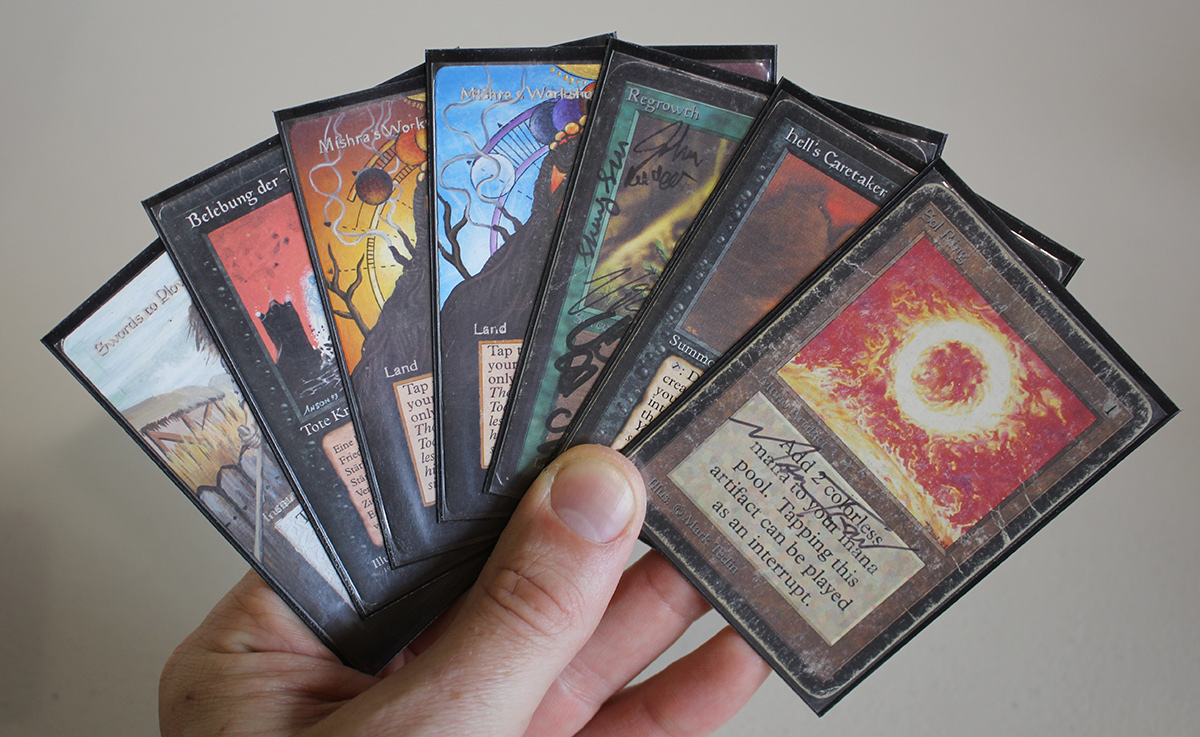
With two Workshops but no castable cards in hand, this is a quick mulligan.
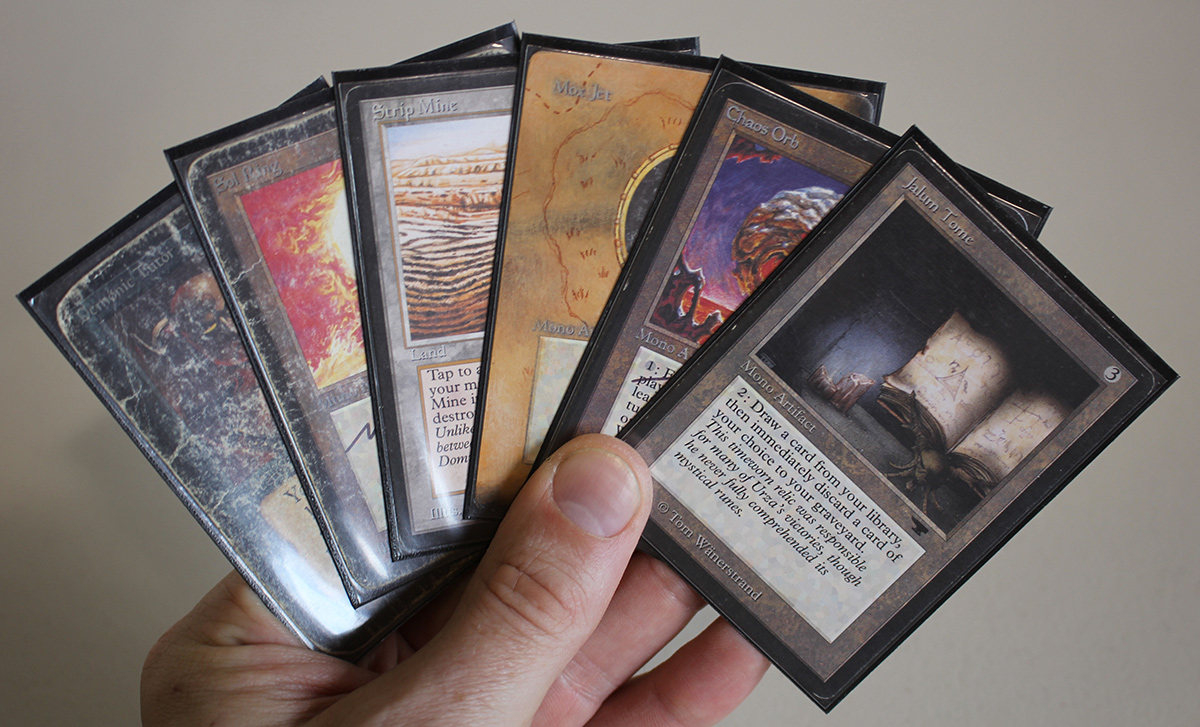
This had features a number of very powerful cards, and disruption in the form of Strip Mine and Chaos Orb, so it’s good enough to keep. Situations like this with non-blue decks (where you don’t just immediately tutor for a card advantage or removal spell) will often demonstrate that a singleton addition like Greed may be a worthwhile consideration when building your deck.
Opening Hand 10
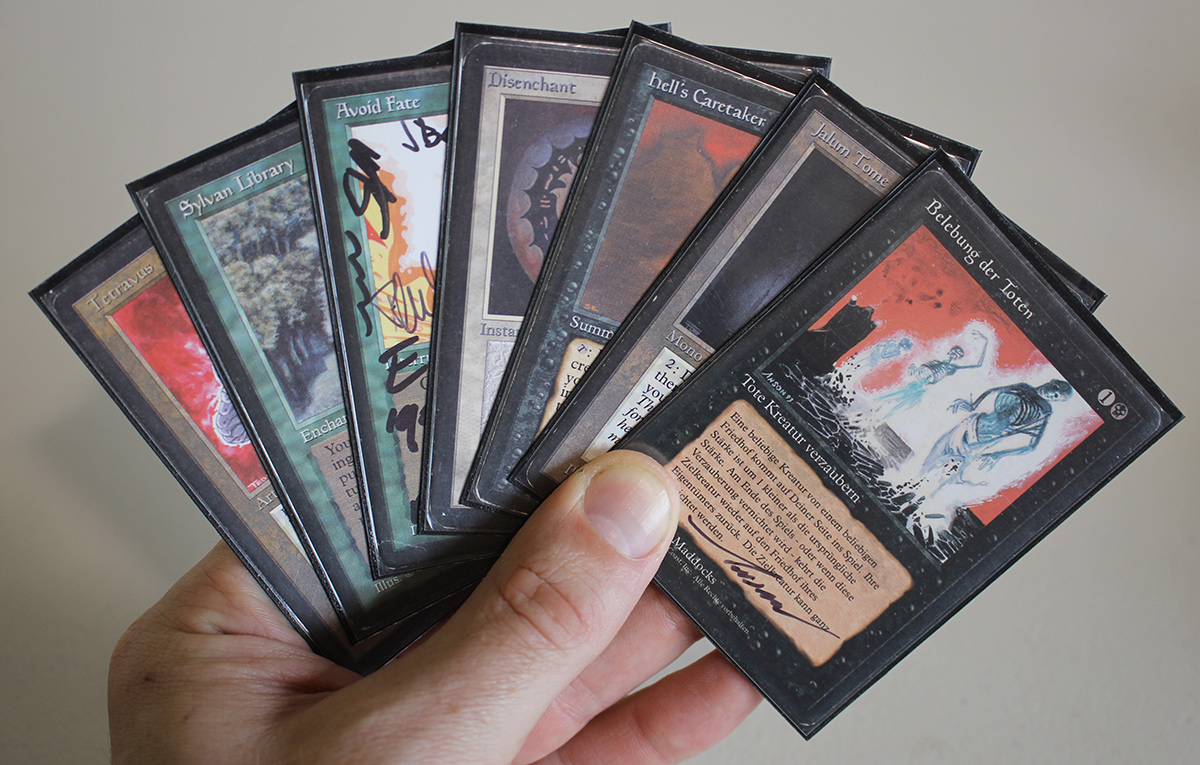
With no mana and no Bazaar this hand has no hope. Let’s shuffle up for a better six.
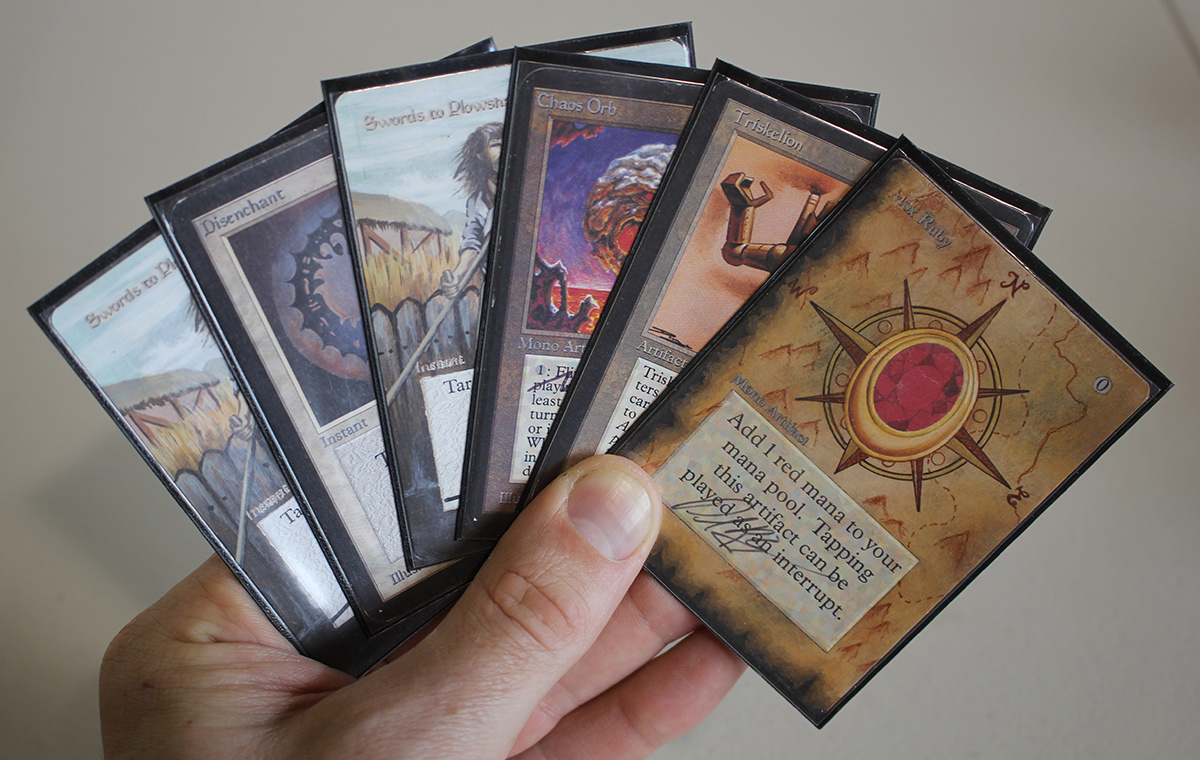
Again, we are hamstrung by a lack of mana, or a reasonable path to victory. Let’s mulligan again to five, and hope to map out a plan.
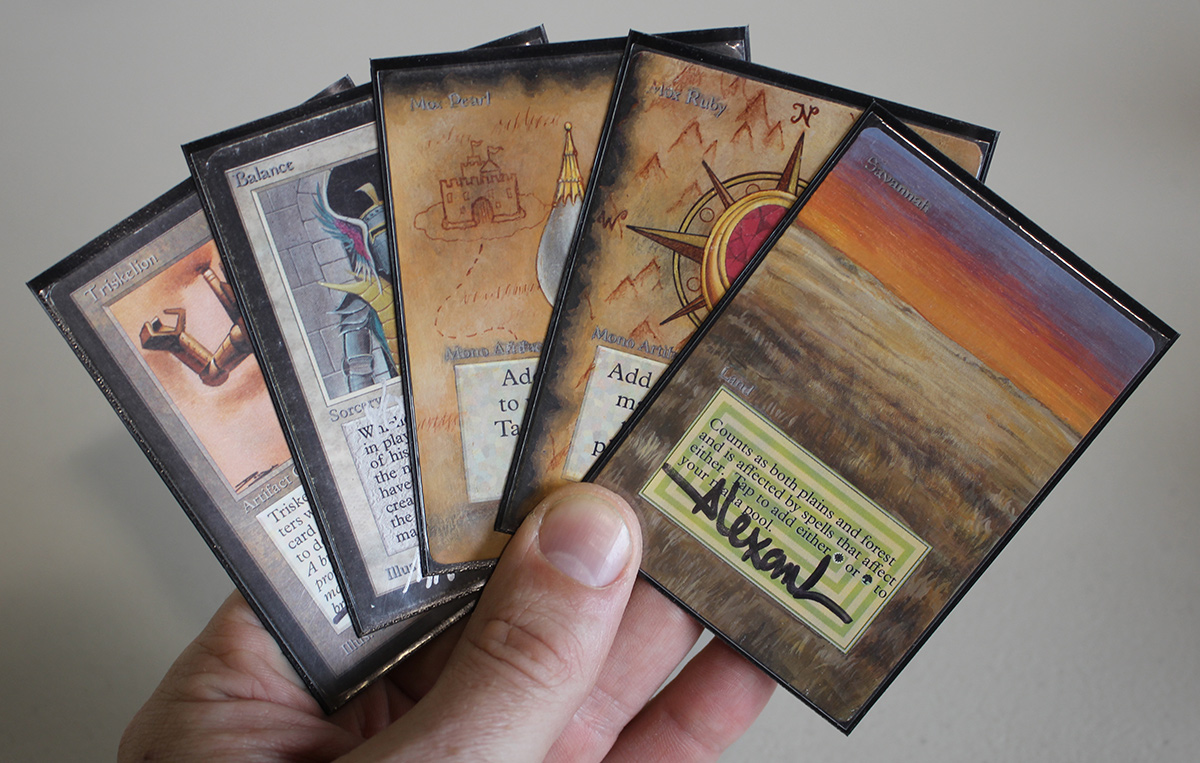
While this hand isn’t dropping a fast creature or getting a draw engine online, it features fast mana and a potentially devastating Balance, and is only a Mishra’s Workshop away from simply hard casting Triskelion. This is a very nice hand of five, and Balance can easily get us back in the game from our mulligans.
Concluding Thoughts
This deck is not cheap to build, but if you are a Vintage player or a long time Old School player you likely have many or most of these cards already anyway. It is not one that translates well to a budget deck unfortunately, because many of the most powerful cards and hands are premised on doing something explosive quickly, and that explosiveness usually comes in the form of fast artifact mana, Mishra’s Workshops, or Bazaar of Baghdad.
JunkShop Reanimator is one of my favorite decks in Old School 93-94, because it is a hybrid strategy that presents serious threats quickly, has plenty of removal, and has a robust and potentially abusable draw engine. Give it a try next time you want to forego a blue strategy, or to bust out the Workshops in your Old School metagame.

